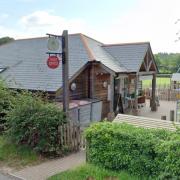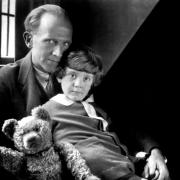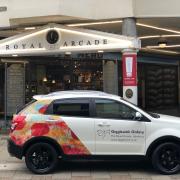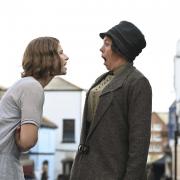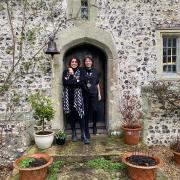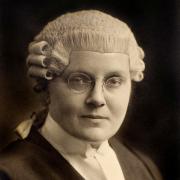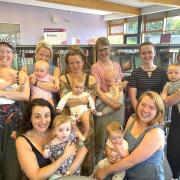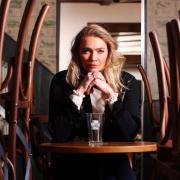From Eliza Acton to Elizabeth David, some of the UK’s most influential food heroes have made their home here

This has been a good year for home cooking. Thanks to the lockdown in spring and the enduring popularity of TV shows such as Bake Off and MasterChef, many of us have been dusting down our recipes and rediscovering the joys of home-cooked fare like never before.
In Sussex, creativity in the kitchen is nothing new. Through history our county has been home to a number of inventive women whose ideas about food have shaped the nation’s eating habits.
Take Eliza Acton, for example. Born in Battle in 1799, this innovative woman gave us the modern cookery book as we know it. Her Modern Cookery for Private Families, published in 1845, might not have been the only collection of recipes in the English language but it was the first to separate the ingredients and cooking times from the method, an idea so ingenious that it set the template for every cookbook that followed.
Acton’s book was also novel in that it targeted the amateur home cook rather than professionals. The burgeoning Victorian middle class, who could afford to put on a lavish dinner party but not the staff to cook it, lapped up Acton’s well-illustrated instructions for simple, hearty fare such as salmon pudding, cream-baked sole, and “good mutton pie”.
Modern Cookery gave us the first recorded recipes for mulligatawny soup and chutney, and was the first to feature spaghetti and Brussels sprouts (though, thankfully, not in the same dish).
Delia Smith once called Acton, who had a side career as a poet, “the best writer of recipes in the English language”. Modern Cookery still makes exhilarating — and mouth-watering — reading and some of its dishes, such as pineapple marmalade and raspberry puffs, wouldn’t look out of place on a dinner table today, although we may prefer to leave sea kale in gravy, milk lemonade, and mince pies with ox tongue and boiled lemons back in the 19th century.
Modern Cookery ran into thirteen editions and was a Victorian must-read until 1861 when Isabella Beeton with her Book of Household Management, which freely plagiarised Acton’s work, took over as everyone’s favourite domestic goddess.

Folkington was the childhood home of 1913-born Elizabeth David, another woman who was going to have a profound – and joyful – effect on our eating habits. When David returned to Britain in 1946 after several years’ working and travelling around southern Europe and Egypt, she was dismayed to find the post-war national diet rarely straying from plain meat and stodgy puddings.
Used to a healthy Mediterranean diet, she took out her frustration by writing a cookery column for Harper’s Bazaar, in which she extolled such little-known foodstuffs as basil, aubergines, and garlic.
Her extraordinary A Book of Mediterranean Food followed in 1950. With a striking cover by artist John Minton that depicted the bright blues of a sunny sky and a table laid out by the sea, the book tempted the jaded British palate with moules marinières, bouillabaisse, moussaka and other flavoursome novelties that evoked lunches in Greek tavernas and trips to markets on the Côte D’Azur. For many, suet pudding and cabbage would never be the same again.
MORE: Read our review of East Grinstead restaurant Paglia and Fieno by Laura Paton
David produced many more books, exploring the cuisines of the Mediterranean. These, with her magazine columns, brought delights such as risotto, lasagne and ragu into the mainstream while putting courgettes, dates, and olive oil onto our supermarket shelves for ever.
Our tour of pioneering Sussex cooks stops next at Brighton, the home of true twentieth-century food icon, Marguerite Patten.
Rare is the person who has never owned a Patten cookbook. Her 170 volumes span everything from Soups and Savouries to Homemade Wines and Drinks to Fondues and everything in between. Born in Bath, the young Patten became interested in cooking when her father’s death placed her in the role of helper to her working mum.

As a home economist during the war, her straight-talking style and likeability made her the ideal host for BBC radio’s Kitchen Front, an attempt by the Ministry of Food to show a baffled nation how to cook nutritious dishes from unpromising ingredients.
Cheerfully, Patten held many a housewife’s hand as they took on pea–pod soup, eggless fruitcake and ‘duck’ made from cooking apples and sausage meat. At one of her last public appearances in 2009, Patten aged 94, regaled an audience at Brighton Museum with tales of her attempts to make something tasty from whale meat.
After the war, Patten was still in demand with her cookery demonstrations selling out venues around the country. By now, pea-pods and whale-meat had gone and trickier dishes such as baked Alaska, quiche and soufflé were making their tentative way onto the nation’s tables.
Patten’s sumptuously photographed volumes and recipe cards emboldened unconfident cooks to attempt novelties like nettle soup, lamb paprika, and apple tomato moulds as well as exploring the cuisines of other countries.
Unlike Elizabeth David who appeared on TV only once, Patten was part of Britain’s first magazine–type TV programmes Designed for Women and Cookery Club until 1961. Although undoubtedly our first celebrity chef, she never liked the label, telling The Telegraph in 2011, “to the day I die, I’ll be a home economist.”
The BBC’s Kitchen Front also drew upon the talents of two Steyning-based sisters. Elsie and Doris Waters, born in 1893 and 1904 respectively, were better known as comedy duo ‘Gert and Daisy’, whose popular routine as cockney women chatting over the garden fence were considered just the thing to teach ordinary working women about rationing and nutrition as the war progressed.
With Gert and Daisy, Kitchen Front regularly attracted up to seven million listeners and even led to the Gert and Daisy’s Cookery Book, a copy of which is part of the interesting Gert and Daisy archive at Steyning Museum.
Our final cooking pioneer is the most controversial. Fanny Cradock, born Phyllis Nan Pechey in Leytonstone in 1909, lived in Bexhill, Chichester and finally Hailsham.
Unlike Marguerite Patten, Cradock fully embraced the role of celebrity chef. When she bounced on our screens in 1955 in the BBC’s Kitchen Magic, she brought personality, glamour — who can forget her cooking in a ballgown? — and non-stop badgering of partner Johnny.
Cradock’s food was distinctive. A fondness for dramatic garnishes and food-colouring produced purple mashed potatoes, green cheese ice-cream, mauve hard-boiled eggs, pigeon breasts with wings re-attached and many other creations as flamboyant and psychedelic as the fashions of the time.
Behind Cradock’s larger than life persona, however, was a woman who was genuinely passionate about food. Although many of her recipes – egg lemonade, German beer cake, elderflower gin jelly – would be considered rich for today’s tastes, they certainly don’t sound boring.
Sadly, Cradock’s TV career ended abruptly when she was rude to an amateur on The Big Time in 1976. However by then she had already helped to establish cooking as entertainment and laid the gauntlet for the larger-than-life TV chefs that followed her.
Sussex has long been acknowledged as a centre for gastronomy with its award-winning wines, world famous beers, hearty puddings, pies, ponds and hotpots. Coupled with the great ideas, recipes, writing, and outstanding talent that our area has nurtured, we really can stake a claim to be Britain’s cooking county.
Join the conversation on our Facebook, Twitter and Instagram pages




